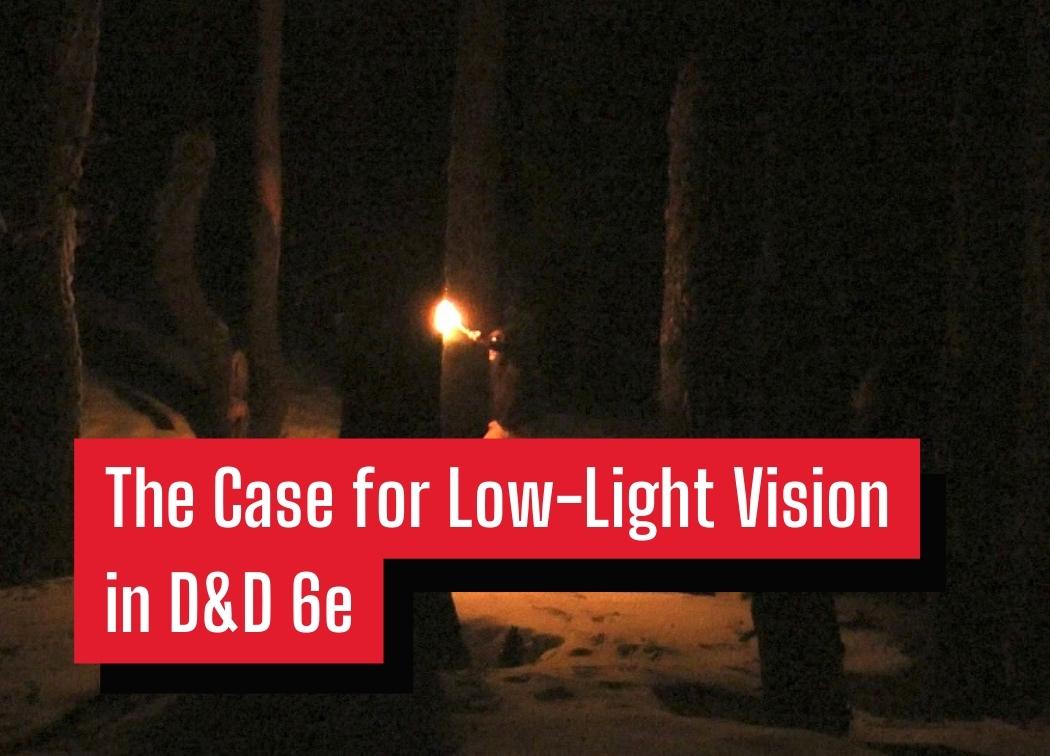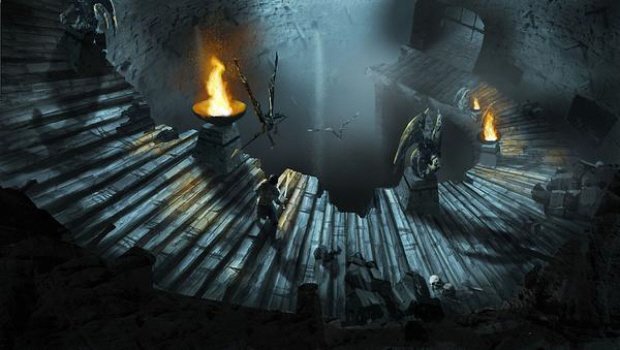The Case for Low-Light Vision in D&D 6e

Recently I picked up Shadow of the Demon Lord and first of all, it’s fantastic and I can’t wait to get around to playing it. But more importantly, the Shadowsight mechanic reminded me of a major issue I have with D&D 5e, darkvision.
Shadowsight in Shadow of the Demon Lord allows certain creatures and characters of certain ancestries see in areas obscured in shadows. This is similar to D&D 3.5e’s low-light vision mechanics. Essentially, creatures and characters with these traits can see in areas with very little light.
For some reason, in 5e this mechanic was thrown out the door and replaced by darkvision. Some creatures and characters with darkvision can see in full color in pitch-black rooms, but any creature with darkvision can see in shades of gray just fine.
It’s also a binary trait. Either you have darkvision and can see in the dark, or you don’t and essentially suffer the blinded condition when looking around in total darkness. In dim light, a creature without darkvision just has disadvantage on Wisdom (perception) checks.

There are plenty of spells that can create visible light to aid in creatures’ navigation in pitch-black caves and dungeons. You could light a lantern or a torch as well if you or an ally are playing a character without darkvision, so it’s not like it’s the end of the world to not play as a race that has darkvision.
But all of this is devalued when the majority of the playable race options have darkvision. Many of which, in my opinion, don’t make a ton of thematic sense to have the ability to see in absolute darkness.
The Problem: Everyone has Darkvision
My problem isn’t the darkvision mechanic in 5e. My problem is that practically everyone has it. It’s not unique or special and doesn’t add a whole lot of flavor to character races because of this. It also makes walking into a deep, dark dungeon a bit less risky when most of your party can see just fine.
There are class archetypes like the Gloomstalker Ranger that have darkvision as part of their features. If you already have darkvision in this case you increase the distance that you can see with your darkvision.
This doesn’t feel nearly as rewarding as gaining the ability to see in the dark outright since there’s a great chance you have it already. What should be a cool, thematic, flavorful feature is now just a tacked-on feature because of how common darkvision is.
Dark caves and unlit dungeons feel much less dangerous now that the majority of non-human characters have darkvision. Creatures can’t rely on the cover of darkness alone to shroud them for an ambush, they need to be a bit more crafty. Unlit, unexplored areas can be traversed as normal.
Darkness as an element of a dungeon or cave isn’t as scary in D&D 5e as it is in other games and previous D&D editions. It’s one less tool that the DM can use to spice things up in their adventure or encounter.
Mechanical Issues
Mechanically speaking, there are a few issues with darkvision being so common. There are cantrips and lesser magical items that create a light source or grant darkvision that now don’t feel super useful unless your character is a human or one of the few races that don’t have darkvision. But even without these magical options, you could simply use a light source like a cheap torch.
My point is that there are plenty of accessible tools and spells that your party could pick up to provide light to those that need it. The issue is that these resources aren’t always being spent on these things because it’s pretty easy to have a party full of people with darkvision.
Holding a torch or a lantern would require a character to use their offhand and spend some money. Using the dancing lights cantrip requires concentration. Magical items that act as light sources or grant darkvision are expensive or require attunement. There’s a cost to everything and it’s easy to completely avoid.
Plus, stealth operations in the dark become a lot riskier when your group needs a light source. Do you light a torch and hope for the best, or do you deal with having trouble navigating your way without the use of your sight? Choices make RPGs more fun.
But a Lot of Creatures Have Darkvision Too
In my opinion, a large number of creatures having darkvision don’t create as many issues as the player characters having darkvision. Creatures are in the game to give the player’s an enemy to fight, a challenge to face.
Giving creatures an extra tool or advantage over the players is good since it can create challenging situations. Darkvision is one such challenge. Creatures can operate in total darkness as if it were dim-light if they have darkvision. This means that they have a new element at their disposal to use against the party.
It’s not as much of an issue to create a challenge or a disadvantageous position for the party. It gives them a new challenge to face and forces them to come up with a solution, which a big point of playing RPGs.
The players having plenty of opportunities to gain darkvision and take away potential challenges during character creation is a problem.
If a creature thematically doesn’t have a reason to have darkvision it is still a part of the problem. I just don’t find it to be nearly as much of an issue as player races being loaded with races that have darkvision.
The Solution: Bring Back Low-Light Vision
Notice that I did say 6e in the title. I don’t expect this issue to ever be fixed for 5e, it’s a huge change. At this point, even if an errata was released for 5e that made darkvision rarer it wouldn’t have a huge effect. Not everyone pays attention to errata anyways.
It’s also an enormous change to make mid-edition (though I bet 5e has much more life than that). I don’t think it’s a feasible problem to tackle right now. However, it’s one that I hope the next iteration of Dungeons and Dragons addresses.
Personally, I think that in D&D 6e the designers should take a look at low-light vision again. It’s a good middle-ground between stripping a ton of magical races of darkvision and giving said races darkvision when it doesn’t make a ton of sense.
For example, elves are innately magical beings. It’s understandable that their eyesight is enhanced compared to that of a human’s. It doesn’t make sense for a wood elf to be able to see well in a cave system with absolutely no light. They’re out of their element. Therefore, they should have low-light vision.
A drow, though is a different kind of elf. They live in places where there is no natural light and have adapted to be able to see just fine. It’s perfectly reasonable that they should have darkvision.
Having a middle-ground for the types of vision is a great answer to this issue both in terms of the game mechanics and overall flavor. Low-light vision still gives these races a mechanical benefit that others don’t get, but not at the cost of impeding on races where darkvision creates a unique identity for them.
Conclusions
As I said, I like darkvision as a mechanic, but the implementation is what makes it an issue for me. I’d love it if it was reserved for creatures and races where it makes sense, like if they live underground.
The inclusion of low-light vision makes darkvision a lot more flavorful and gives more value to all of the equipment, spells, and features that grant darkvision. That’s why it’s part of my wish-list for D&D 6e that it gets added back into the game and the character races get a bit of retooling.
On the other hand, it’s one more mechanic to remember for a mechanically-dense game. However, if low-light vision isn’t the solution for 6e, darkvision should be stripped from quite a few character races to make things a bit more interesting.

I think it’s worth noting that darkvision doesn’t mean you see in the dark “just fine”. It means you can see “in darkness as if it were dim light”. Dim light = lightly obscured = disadvantage on perception checks (or -5 to passive perception). This means hiding in the darkness can still be effective even against creatures with darkvision.
I agree with many of the points you made in your arguement. I feel that even for subterranean races they shouldn’t be able to see in COMPLETE darkness unless their race has been magically enhanced. So in dim light or low light they can see, that makes sense but without some kind of light source it just doesn’t make thematic sense… even creatures whom have adapted to see in complete darkness don’t do so by sight, they do it via other senses: tremor sense, sonar, antenae, whiskers, tentacles, etc.
In my games, I always homebrew the rule that you can’t see in the dark (regardless of what the race says) unless there is a magical assist you have and ‘dark vision’ is equated to ‘low light vision’ where you can see in starlight/dim light as if it were bright light…
My fellow player/DM and I are going to reintroduce Low Light to our two campaigns in a couple sessions. We talked back and forth between us about what makes sense, we researched how nightvision goggles work IRL, and looked at a lot of blogs / articles / reddits. And basically, if you live on the surface, you are *at best* Low-Light (which doubles sight ranges from light, and gives 10′ dim vision if there is *any* ambient light, like stars); if you live underground, you have Darkvision. And Darkvision – while working RAW – is specifically an *active* sense, projecting near-IR and near-UV light and then “reading” the return. And because of that, *other* Darkvision beings can see *you*!
When in doubt, check 3e to see what the race used to have! Never mind that 5e upgraded all Low-Light races to Darkvision… they flat out gave it to races that used to be limited to “merely human” sight! (Like Changelings) And reduced cats to being night-blind? I meant really, wtf?